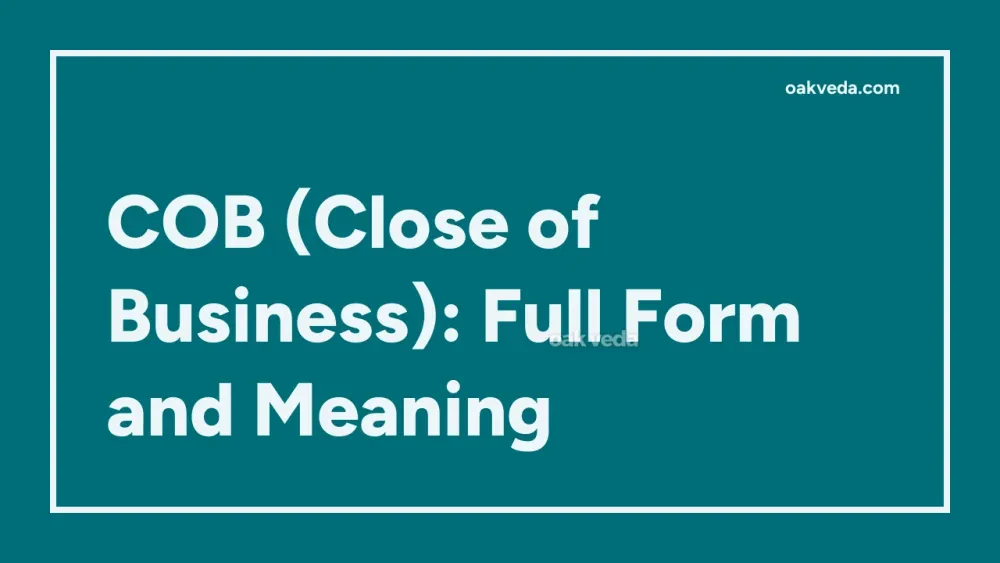
What is the Full Form of COB?
The full form of COB is "Close of Business." This abbreviation is widely used in the business world to indicate the end of a typical workday or when business operations cease for the day. COB is often used interchangeably with other similar terms such as EOD (End of Day), EOB (End of Business), COP (Close of Play), or EOP (End of Play).
What is Close of Business?
Close of Business refers to the time when a company or organization officially ends its business activities for the day. This concept is crucial in various industries, as it helps establish clear deadlines and expectations for completing tasks, submitting reports, or finalizing transactions.
Origin and Development of Close of Business
The concept of Close of Business has been around for as long as businesses have operated on fixed schedules. However, the abbreviation "COB" gained popularity with the rise of global commerce and the need for clear communication across different time zones. As businesses expanded internationally, the term became essential for coordinating activities and setting expectations for work completion.
How does Close of Business work?
Close of Business typically marks the end of the standard working hours for a company. For example, if a business operates from 9:00 AM to 6:00 PM, the COB would generally be at 6:00 PM. However, it's important to note that the exact time can vary depending on the industry, company policies, and geographical location.
When someone says a task needs to be completed by COB, it means the work should be finished before the office closes for the day. This helps in setting clear expectations and ensures that all necessary work is completed within the business day.
Functions of Close of Business
- Deadline Setting: COB serves as a clear cutoff point for task completion, report submissions, or transaction processing.
- Work-Life Balance: It helps establish boundaries between work and personal time for employees.
- Business Operations: COB often marks the time when certain business processes, such as daily accounting reconciliations, are performed.
- Communication: It provides a common reference point for teams working across different time zones or schedules.
Applications of Close of Business
COB is used in various contexts across different industries:
- Finance: Banks often use COB to indicate when daily transactions will be processed or when funds will be available.
- Stock Market: Trading hours are typically defined by the market's opening and closing times.
- Project Management: Deadlines for deliverables are often set at COB to ensure timely completion.
- Customer Service: Support hours may be defined using COB to set expectations for response times.
Features of Close of Business
- Flexibility: The exact time for COB can vary between companies and industries.
- Industry-Specific: Different sectors may have unique interpretations of what constitutes COB.
- Time Zone Considerations: Global businesses often need to specify which time zone they're referring to when using COB.
- Non-Legal Term: COB is a business convention rather than a legally defined term.
Benefits of Using Close of Business
- Clear Communication: It provides a universally understood reference point for deadlines.
- Improved Productivity: Setting COB deadlines can motivate teams to complete tasks within the workday.
- Better Time Management: It helps in planning and prioritizing tasks throughout the day.
- Work-Life Balance: Clearly defined end-of-day times can help prevent work from spilling into personal time.
Limitations or Challenges of Close of Business
- Time Zone Differences: In global operations, COB can be confusing if the time zone isn't specified.
- Varying Interpretations: Different industries or companies may have different understandings of when COB occurs.
- Overtime Issues: Strict adherence to COB may not account for necessary overtime or flexible working hours.
- 24/7 Operations: For businesses that operate around the clock, the concept of COB may not be as relevant.
Future Developments in Close of Business Practices
As the nature of work continues to evolve, particularly with the rise of remote and flexible working arrangements, the concept of COB may need to adapt. Future developments might include:
- Personalized COB: Companies may move towards more flexible, employee-specific COB times.
- Digital COB Indicators: Advanced project management tools might incorporate automated COB notifications.
- AI-Assisted Scheduling: Artificial intelligence could help optimize COB times based on team productivity patterns and global collaboration needs.
FAQs on COB Full Form
-
Is COB the same as EOD? While often used interchangeably, COB specifically refers to the end of business operations, while EOD (End of Day) can be more general and may extend beyond business hours.
-
What time is typically considered COB? In the United States, COB is often considered to be 5:00 PM local time. However, this can vary by company and industry.
-
How does COB differ internationally? COB times can vary significantly across countries. For example, in the UK, COB is often considered to be around 5:30 PM.
-
Is COB a legally binding term? No, COB is not a legally binding term. It's a business convention that can be interpreted differently across organizations.
-
How should COB be used in global business communications? When using COB in global communications, it's best to specify the time zone or provide an exact time to avoid confusion.
By understanding the full form and implications of COB, businesses can improve their communication, set clear expectations, and enhance overall productivity. As work environments continue to evolve, the concept of Close of Business will likely adapt to meet the changing needs of the global business landscape.
You may be interested in:

